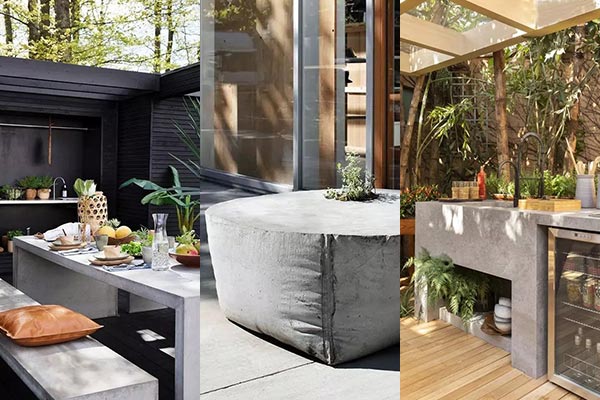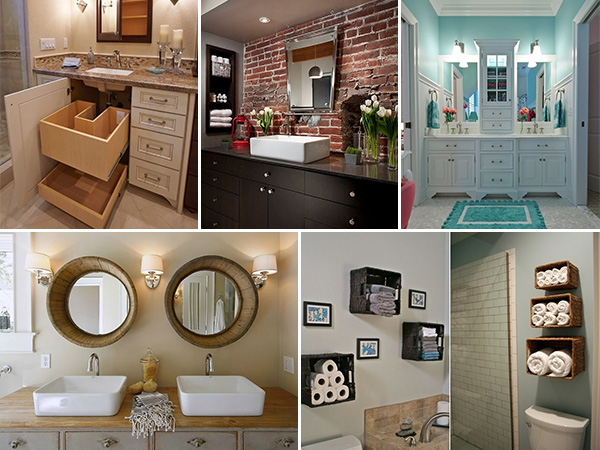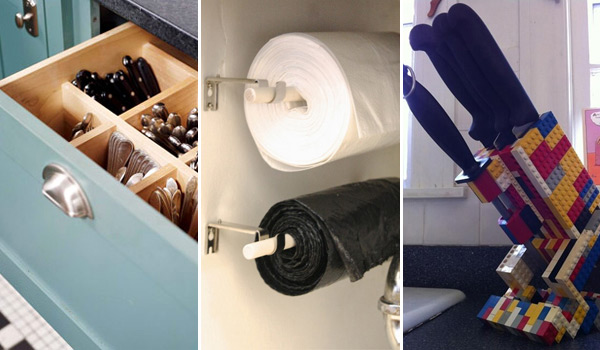Top 6 Best Types of Gravel for Driveways (With Pros & Cons)
Simple Guide for Strong, Low-Maintenance, and Beautiful Driveways
Choosing the best gravel for your driveway can make a big difference in how your home looks and how easy it is to maintain. With so many types of driveway gravel available—like crusher run, pea gravel, river rock, and marble chips—it’s important to know which one fits your needs, budget, and climate. Some gravels offer great drainage and stability, while others focus more on appearance and low maintenance. In this guide, we’ll walk you through the 6 best types of gravel for driveways, complete with pros and cons for each, so you can build a driveway that’s not only functional but also beautiful and long-lasting.

In this post, you’ll also discover the most popular gravel types for driveways and learn what to keep in mind when choosing the right one. We’ll break down the different gravel sizes, explain how each is used, and highlight which ones work best for standard, sloped, or muddy driveways. You’ll also find a helpful gravel size chart to guide your decision-making.

What Is the Best Gravel for a Driveway?
The best gravel for a driveway usually includes stones ranging in size from ½ inch to 1 inch, mixed with smaller particles and dust. This blend creates a firm surface. The fine dust helps the gravel pieces lock together while still allowing water to drain, which helps avoid puddles and mud.
You can choose from several types of gravel depending on your budget and the look you want. Some popular choices are crusher run, decomposed granite, marble chips, Jersey Shore gravel, pea gravel, and river rock. But remember: not all gravels work the same. Some, like pea gravel and river rock, tend to move around easily, which means they need edging to stay in place.
Types of Gravel for Driveways (With Pros & Cons)
Gravel driveways can be made from natural gravel or crushed stone. Natural gravel is rounded and smooth because it’s formed by nature, often by rivers or glaciers. Crushed stone, on the other hand, is made by crushing rocks like granite or limestone into angular pieces.
Gravel comes in different sizes, from large chunks to fine dust. For driveways, different layers are used. Bigger stones go on the bottom, and smaller gravel goes on top to create a smoother finish.
1. Pea Gravel

Pea gravel consists of small, round stones about ⅛ to ⅜ inch in diameter. It can be naturally rounded or slightly angular if crushed. Pea gravel comes in many beautiful colors like gray, red, tan, brown, green, and white, and is often used in gardens, around walkways, or between paving stones.
It’s soft underfoot and available in small bags or large amounts by the ton. However, it tends to move around when stepped on or driven over, so it needs strong edges to keep it in place.
| Pros | Cons |
|---|---|
| Easy to install | Moves around when walked or driven on |
| Attractive, colorful appearance | Needs borders to stop it from spreading |
| Holds moisture and blocks weeds | |
| Doesn’t attract rodents |
2. River Rock

River rock is made up of smooth, rounded stones ranging from ⅜ inch to 5 inches. These rocks are often naturally formed but can also be smoothed by machines. They come in many colors and are often used for landscaping, water features, and borders.
River rock is heavier than other gravel types, so it tends to stay in place better. However, it can be slippery and uncomfortable to walk on, especially when wet.
| Pros | Cons |
|---|---|
| Heavy—stays where you place it | Hard and uncomfortable to walk on |
| Good for preventing erosion | Slippery when wet |
| Comes in many natural colors |
3. Crusher Run

Crusher run is a mix of ¾-inch crushed limestone and stone dust. It’s also called ABC (Aggregate Base Course) or GAB (Graded Aggregate Base). The small particles fill in the gaps between the stones, making the surface solid and stable.
This gravel type is great for driveways, parking areas, patios, and even foundations. It compacts really well and forms a smooth, solid surface that still lets water pass through, helping with drainage.
| Pros | Cons |
|---|---|
| Compacts well and stays put | Needs heavy equipment and skill to install |
| Forms a solid and even base | Can have drainage issues if not laid correctly |
| Readily available | |
| Has a consistent appearance |
4. Decomposed Granite (DG)

Decomposed granite is granite that has naturally broken down into small particles over time. It usually contains sand, clay, and gravel dust. Depending on where it’s from, its color can be red, pink, gray, brown, black, or white.
This material is popular for driveways, walkways, patios, and landscaping borders. It compacts nicely, stays in place, and lets water drain. It’s budget-friendly and helps prevent erosion and weeds, though it may not hold up well during snow removal.
| Pros | Cons |
|---|---|
| Easy to compact and very stable | Can get displaced when shoveling snow |
| Helps with water drainage and erosion control | May form potholes depending on base prep |
| Prevents weeds, pets, and rodents | |
| Inexpensive and ideal for wet ground |
5. Jersey Shore Gravel
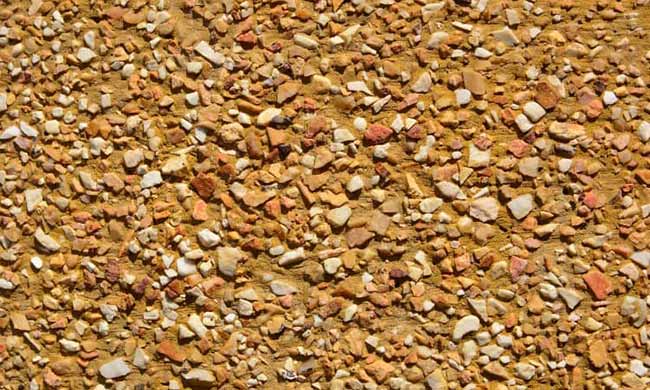
Jersey Shore gravel is known for its beachy, yellowish color that resembles sand. It’s a blend of tan, gold, and white stones. Like pea gravel, it comes in small sizes like ⅜” and ¾”.
This type is often used for decorative purposes, including driveways, walkways, and garden areas. It looks great and helps with moisture retention, but it can be uncomfortable to walk on barefoot and needs edging to stay in place.
| Pros | Cons |
|---|---|
| Unique sandy look | Can spread without borders |
| Inexpensive | Rough on bare feet |
| Helps keep moisture and block weeds |
6. Marble Chips

Marble chips are shiny white or colorful crushed marble stones. They’re made from leftover marble and have angular edges. They reflect sunlight, so they sparkle and make driveways or gardens look elegant.
Besides being decorative, marble chips help hold water, reduce weeds, and last a long time. However, they are more expensive and can scatter if not edged properly.
| Pros | Cons |
|---|---|
| Sparkly and beautiful | Costly compared to other gravels |
| Available in uniform colors | Needs edging to stay in place |
| Helps with moisture and weeds |
What Size Gravel Works Best for a Driveway?

Creating a strong driveway isn’t just about laying stones on the grass. You need to dig at least 12 inches deep to remove topsoil and prepare a base. A good base uses larger stones like #3 (½” to 2”) or #5 (1” to 1½”), which allow drainage and prevent sinking.
The top layer should be smoother, using #57 (½” to 1”), #67 (½” to ¾”), or #411 (includes dust and small screenings). #411 is especially stable because the dust locks the stones together and prevents shifting.
Gravel Size and Price Chart
| Type | Stone Size | Average Price (Per Ton) |
|---|---|---|
| #5 | 1” or smaller | $240 (1 ton) to $98 (21 tons) |
| #8 | ⅜” to ½” | $112 to $55 |
| #57 | ½” to 1” | $125 to $60 |
| #67 | ½” to ¾” | $112 to $58 |
| #411 | ½” to 1” with dust/screenings | $121 to $62 |
Best Gravel for Driveways on a Slope
Driveways on hills need gravel that stays put and doesn’t roll. Crushed stone is ideal because of its angular shape, which improves grip.
Use materials like crusher run, decomposed granite, marble chips, or Jersey Shore gravel. All of these have sharp edges that lock in place. You can also choose #411 gravel, which includes dust to help everything stay compacted on slopes.
Best Gravel for Muddy Driveways
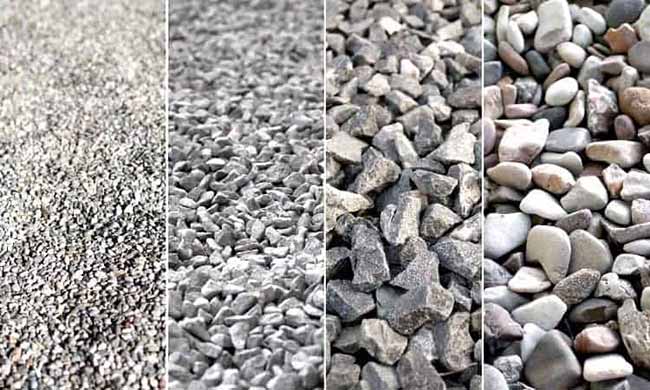
If your driveway is muddy, it usually means poor drainage. Adding more gravel won’t fix it long-term. The best way is to dig out the driveway, install a drainage system, and rebuild it properly.
-
Start by removing the top 12 inches.
-
Lay a fabric barrier to stop the gravel from sinking.
-
Add a base layer of 4”-6” large crushed stones.
-
Then add 5”-7” of 1½”-2” gravel.
-
Finish with 3”-4” of #411 for a stable, smooth top.
This method creates a crown shape, with the middle slightly higher, so water runs off the sides instead of pooling.
How to Choose the Right Gravel for Your Driveway
Picking the best gravel for your driveway goes far beyond selecting a color or texture. It’s about balancing practical performance with visual appeal, and choosing materials that can handle your local climate, soil, and traffic needs. Here’s a complete breakdown to help you make the best decision.
1. What Makes Gravel “Right” for Your Driveway? Key Functional Factors to Consider
To build a driveway that holds up over time, you’ll need to consider a few essential elements:
-
Weather & Climate:
If you live in an area with frequent rain or snow, choose a gravel type that offers excellent drainage. Angular options like crushed stone, crusher run, or pea gravel allow water to pass through easily and help prevent pooling, ice buildup, or erosion. -
Traffic Load:
A driveway that sees frequent vehicle use—especially from heavy cars or trucks—needs a gravel that resists shifting. Durable materials like quarry process (QP) or crushed limestone form a tight surface that stays in place, even under stress. -
Soil Conditions:
Your existing ground matters. Softer or clay-rich soil will need extra reinforcement to stay level. A thick base layer of coarse gravel—like #3 stone or decomposed granite—can help stabilize the foundation and prevent the driveway from sinking over time. -
Layering Strategy:
A long-lasting driveway typically uses a three-layer system:-
Base Layer: Large rocks (1.5”–2”) to support weight and provide drainage.
-
Middle Layer: Medium-sized gravel such as crusher run for compact stability.
-
Top Layer: Finer gravel like #57 or #411 to create a smoother, finished surface.
-
🛠️ Pro Tip: Skipping proper layering often leads to rutting and poor water flow, so always plan for a well-compacted base.
2. How to Match Gravel Style with Your Home’s Aesthetic
While strength and durability are key, your driveway is also one of the first things visitors notice—so looks do matter. The right gravel can elevate your curb appeal and tie your landscape together.
-
For a Natural, Relaxed Feel:
If you want something that blends effortlessly with gardens or rustic settings, pea gravel or river rock is ideal. Their smooth, rounded stones look organic and create a cozy, informal vibe—perfect for country homes or cottage-style designs. -
For a Clean, Modern Finish:
Want something more refined? Go with crushed granite or limestone. These gravels have angular edges and often come in elegant shades of gray, white, or black that pair beautifully with contemporary or classic architecture. -
For Uniformity and Structure:
If you prefer a tidy, minimalist look, quarry process or compacted crushed gravel delivers a hard-packed surface with a clean appearance. This option is great for urban or suburban homes where structure and low maintenance are a priority.
🎯 Aesthetic Tip: Try viewing gravel samples in natural daylight and next to your home’s exterior before making a final choice.
Frequently Asked Questions (FAQ)
❌ Which Types of Gravel Should You Avoid for Driveways?
While many gravels look great in landscaping, not all are suitable for driveways. In particular, pea gravel and river rock are less ideal. Both are small and rounded, which means they tend to shift easily when driven or walked on. This constant movement can lead to ruts, uneven surfaces, and even make driving more difficult.
If you love the look of these decorative stones and still want to use them, be prepared to install strong edging around your driveway to keep the stones from spreading. You’ll also need regular maintenance to smooth out dips and keep things tidy.
💡 Tip: Save these gravels for garden paths, patios, or landscaping borders where heavy traffic isn’t a concern.
🛠️ Is There a Type of Gravel That Becomes a Solid Surface?
Yes, some gravel materials can be compacted into a much firmer surface. Two common choices are decomposed granite (DG) and caliche. These materials contain fine particles that help them compact tightly using a plate compactor or roller.
However, decomposed granite, while popular for walkways and patios, is not ideal for driveways because it can break down too easily under car tires and may erode over time if not maintained properly.
Some homeowners try mixing pea gravel with a binding resin to form a more solid surface. This method creates a resin-stabilized gravel driveway that holds together better and resists movement, although it comes at a higher cost.
🚧 What Are the Best Gravel Alternatives for Driveways?
If you’re not convinced that a gravel driveway is right for you, you’re not alone. There are plenty of gravel driveway alternatives that offer a different look or require less maintenance.
-
Concrete – Durable, long-lasting, and great for urban or suburban homes. Requires less upkeep than gravel.
-
Asphalt – A more affordable option than concrete, with good performance in colder climates.
-
Paver Stones – For those who love the look of natural stone, pavers can be arranged in patterns and paired with gravel or sand joints.
-
Permeable Pavers or Bricks – These eco-friendly options allow water to drain through, reducing puddles and runoff.
-
Recycled Materials – Crushed concrete, recycled asphalt, or rubber tiles can also serve as sustainable alternatives.
✅ Gravel isn’t your only option—modern materials can offer both style and practicality depending on your needs and climate.
🧹 How Can I Make a Gravel Driveway Low-Maintenance?
Gravel driveways are affordable and attractive, but they do require occasional upkeep—especially in high-traffic areas. Fortunately, there are ways to reduce maintenance and extend the life of your gravel surface.
Here are a few practical tips:
-
Use the right base layers: Start with a solid foundation using large crushed stone, followed by a compactable middle layer, and finish with a top layer like #411 that includes fine dust for stability.
-
Install edging: Sturdy borders made from metal, brick, or timber help keep gravel in place and reduce spreading.
-
Compact regularly: Use a plate compactor or roller to press the gravel down every few months, especially after rainy seasons.
-
Add binding agents (optional): For a more permanent surface, consider a resin binder or polymeric stabilizer that holds gravel together and minimizes displacement.
-
Keep the surface crowned: A slightly raised middle (crown) allows rainwater to run off the sides, reducing erosion and puddling.

